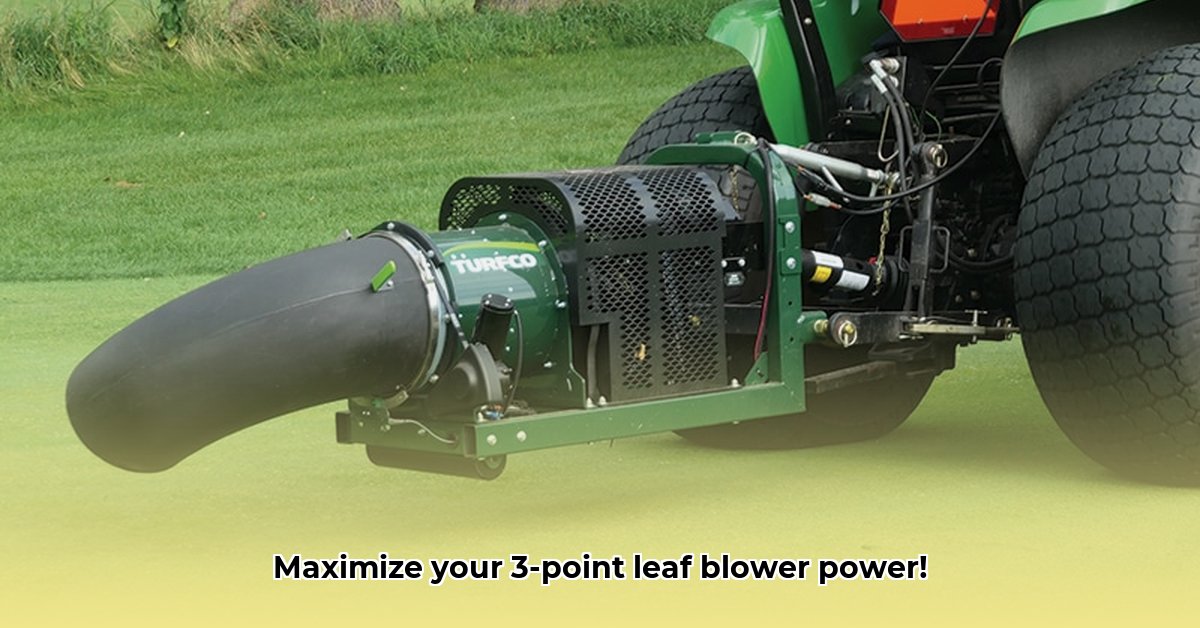
Choosing the Right PTO Leaf Blower for Your Farm
Selecting the ideal PTO-driven leaf blower significantly impacts farm efficiency and operational costs. This comparative review analyzes two leading models—the AgriMetal Max-Flow and the Buffalo Turbine Cyclone PTO—to help farmers make informed decisions. We'll explore their strengths, weaknesses, and long-term implications, focusing on practical applications and sustainable farming practices. For more on tractor implements, see this helpful resource.
Power and Performance: Airflow vs. Airspeed
Both the AgriMetal Max-Flow and the Buffalo Turbine Cyclone PTO promise enhanced efficiency compared to older models. AgriMetal highlights a 25% airflow increase with its Max-Flow impeller, translating to faster cleanup and increased productivity. This higher volume is particularly beneficial for large farms with substantial debris.
Buffalo Turbine emphasizes high airspeed, ideal for clearing stubborn debris like thick leaves or compacted piles. While specific airflow figures are unavailable, the focus on velocity suggests strong performance in challenging conditions. This may be more suitable for smaller operations dealing with less voluminous debris. The choice depends heavily on your farm's specific needs and the type of material you regularly clear. Which blower best suits your operation's debris volume and density?
Design and Durability: A Closer Look at Build and Features
The AgriMetal Max-Flow features a hydraulic deflector system (optional) for precise airflow control, enhancing versatility for managing various materials beyond leaves, such as grass clippings or aeration cores. However, anecdotal evidence suggests potential delays in obtaining the larger roller attachment through dealers.
The Buffalo Turbine Cyclone PTO boasts a lighter weight (240 lbs), simplifying mounting and handling, especially on smaller tractors or in confined spaces. Its 10-year warranty underscores the manufacturer's confidence in its durability. However, information regarding long-term maintenance requirements remains limited. What long-term maintenance costs should factor into your budget analysis?
Feature Comparison: AgriMetal Max-Flow vs. Buffalo Turbine Cyclone PTO
| Feature | AgriMetal Max-Flow | Buffalo Turbine Cyclone PTO |
|---|---|---|
| Airflow Emphasis | High Volume | High Velocity |
| Deflector System | Hydraulic (optional) | None |
| Weight | Heavier | Lighter (240 lbs) |
| Warranty | Unspecified | 10 Years |
| Roller Attachment | Larger roller (dealer-only) | Standard size |
Long-Term Costs and Environmental Considerations
Both manufacturers claim improved fuel efficiency. However, a comprehensive analysis of long-term costs, encompassing fuel, maintenance, and parts replacement, is crucial. Independent testing would provide valuable data. Furthermore, the sustainability of manufacturing processes for both blowers needs further investigation. This includes responsible material sourcing and end-of-life management. What are the environmental implications of each blower's lifecycle?
Making an Informed Decision: Key Considerations
Choosing the right PTO leaf blower involves assessing several key factors:
- Debris Type: Consider the volume and density of the material you regularly clear.
- Tractor Size and Maneuverability: Smaller tractors may benefit from the lighter Buffalo Turbine.
- Budget: Account for both the initial investment and projected long-term maintenance costs.
- Speed and Efficiency: High airflow is crucial for rapid cleanup on larger farms.
By carefully considering these aspects, farmers can select the PTO leaf blower that aligns best with their unique needs and operational style. Remember to consult with other farmers using these models to gather additional insights. What are the critical performance differences under various operating conditions?
PTO vs. Hydraulic: Operational Costs and Sustainable Farming
Choosing between PTO and hydraulic tractor-mounted blowers necessitates a thorough cost-benefit analysis. This section explores the key differences to guide your decision.
Initial Investment and Budget Impact
PTO blowers generally offer lower upfront costs, potentially including used options. However, ensuring sufficient tractor PTO horsepower is vital; inadequate power can lead to inefficiency and equipment damage. Hydraulic systems require a significantly higher initial investment, often including an additional PTO-driven hydraulic pump if the tractor lacks sufficient capacity. This represents a significant capital expenditure. Does the potential for long-term cost savings outweigh the higher initial investment of a hydraulic system?
Control and Maneuverability: Precision vs. Power
Hydraulic systems often provide superior control and maneuverability, allowing for precise airflow direction to protect delicate plants or structures. PTO blowers, while powerful, necessitate greater operator skill for accurate control, especially in tight spaces. How important is precise control for navigating obstacles and protecting your crops?
Risk Mitigation: Protecting Your Investment and Crops
High-powered blowers pose a risk to delicate surfaces like gravel driveways. PTO blowers, due to their raw power, present a higher risk than hydraulic systems. Careful operation, potentially including reduced RPM, is vital. Hydraulic systems, while offering better control, aren't completely immune. What is your tolerance for potential damage to crops or the farm infrastructure?
Long-Term Operational Costs: Maintenance and Repairs
Both systems require regular maintenance; however, the complexity of hydraulic systems potentially leads to more frequent and costly repairs. This needs to be factored into the long-term cost analysis. Can the increased precision of the hydraulic system justify its potentially higher maintenance costs?
The DIY Alternative: Cost Savings vs. Risks
Constructing a custom blower from salvaged components can appeal to budget-conscious farmers. However, this option carries significant risks concerning reliability, safety, and performance. It requires considerable mechanical skills and a comfort level with potential failures. What are the tradeoffs between potential cost savings and the significant risks associated with a DIY approach?
By carefully weighing these factors, farmers can select the system that best aligns with their capabilities and budgetary constraints. The emphasis should be on achieving optimal debris management while minimizing costs and preserving the farm's assets.